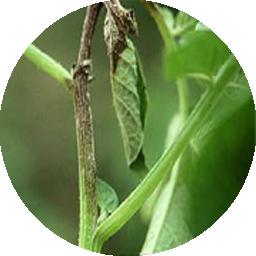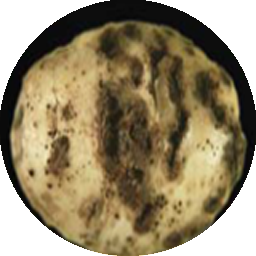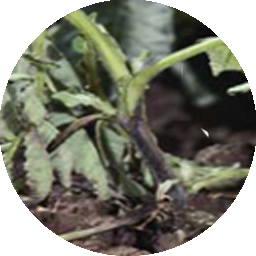Potato Symptoms & Management
×
Symptoms:
1.Initially starts from leaf tips or margins and spread inward
2.Small water soaked or faded green patches on upper surface of leaf which turn brown
3.Spots enlarge and zonations as concentric rings develop in them
4.Downy growth of the pathogen correspondingly on lower surface
5.Progressive defoliation and collapse of plants under favourable conditions
6.Water soaked stripes on stem which becomes necrotic
7.Purplish brown spots appear on skin of tubers
8.On cutting, the affected tubers show rusty brown necrosis from surface to the centre
9.Decay of plant parts under favourable weather which emits foul smell
Management:
1. Regulatory measures restricting movement of infected tubers specially for seed purpose
2. Select healthy tubers for planting
3. Delayed harvesting
4. High ridging to about 10-15 cm height reduces tuber infection
5. Grow resistant varieties such as Kufri Jyothi, Kufri Badshah, Kufri Jeevan, Kufri Sherpa
6. Resistant (R genes) sources: Solanum demissum and S. pimpillifolium Prophylactic measures
7. Copper oxychloride 0.3% or Mancozeb 0.25% or chlorothalonil 0.2% or BM 1% Metalaxyl +Mancozeb 0.2% can be applied at 7 to 10 days intervals in the hills and 10 to 15 days intervals in plains
8. Dip sprouted tubers in 0.2% Metalaxyl for 30 min before
×
Symptoms:
1.Disease occurs early in the season on 3 weeks old plants
2.Dark brown necrotic spots with yellow halo develop on older leaves
3.Spots characteristically show zonations or concentric rings that give a target board look
4.Chlorosis and necrosis extend beyond the infected tissue because of alternaric acid toxin produced by the pathogen
5.Under favourable conditions, spots become hard and shots holes may develop
6.Severe infection may result defoliation and stem rotting
Management:
1. Crop rotation not involving potato or tomato for two years
2. Field sanitation to the extent possible
3. Select healthy tubers for planting
4. Sparying Zineb 0.25 or Mancozeb 0.25% or Propineb 0.2% or Captan 0.2% or Copper oxychloride 0.25% two to three times at 7 to 14 days interval
5. Grow resistant varieties such as Kufri Naveen, Kufri Sindhuri, Kufri Jeevan,
6. Resistant sources: Solanum andegena
×
Symptoms:
1. The bacterium enters through unsuberized lenticels and causes infection of tubers., Produces a toxin called thaxtomin which is of significance in pathogenesis.
2. Two types of scabs are produced: shallow scab and deep lesions scab.
3. In shallow scab, tubers shallow superficial roughened areas often slightly sunken below, the plane of healthy skin. Small brownish and slightly raised spots on tubers may develop.
4. In deep lesion scab, lesions may be as deep as 3 mm or more and darker than shallow, lesions. These lesions enlarge, coalesce and become corky.
5. Infected tubers will become unfit for consumption and lose their market value.
Management:
1. Use of disease free tubers
2. Crop rotation with wheat-oat or potato-onion-maize (4yrs)
3. Green manuring before planting potato
4. Dipping of seed tubers in 3% boric acid for 30 minutes before planting
5. Maintaining soil pH at about 5.2 by addition of sulphur
6. Biocontrol with Bacillus subtilis.
×
Symptoms:
Disease occurs in two phases –
Blackleg of shoots and soft rot of tubers Blackleg
1.Plants are stunted with a stiff, erect growth habit
2.Foliage becomes chlorotic and the leaflets tend to roll upward at the margins.
3.Stems of infected plants exhibit an inky black decay
4.The base of the stem is often completely rotted
5.Plants may wilt
6.In relatively dry soil, only the pith may show blackening
Soft rot symptoms
1. Infection starts in field or/and storage
2. Soft rot include rotted tissues that are wet, cream to tan in color, and soft
3. Rot begins on the tuber surface and progresses inward
4. Infected tissues are sharply delineated from healthy tissue by dark brown or black margins
5. Shallow necrotic spots on the tubers result from infections through lenticels
6. Rotting tissue is usually odourless in the early stages of decay, but develops a foul odor as secondary organisms invade infected tissue
7. Soft rot also infects wounded stems and roots
Management:
1. Crop rotation with cereals
2. Healthy seed tubers should be planted after treating with Streptocycline 100ppm and CuSo4 40ppm for 30 min
3. Crop should be planted in well drained areas and at sufficient distances to allow adequate Ventilation
4. Avoid wounding of plants during intercultivation and tubers at harvest, transport and storage
5. Remove all debris from warehouses and disinfect the walls with formaldehyde or copper sulphate
6. Products to be stored should be dry, and the humidity and temperatures of warehouses should be kept low
7. Control flies in field and storage




